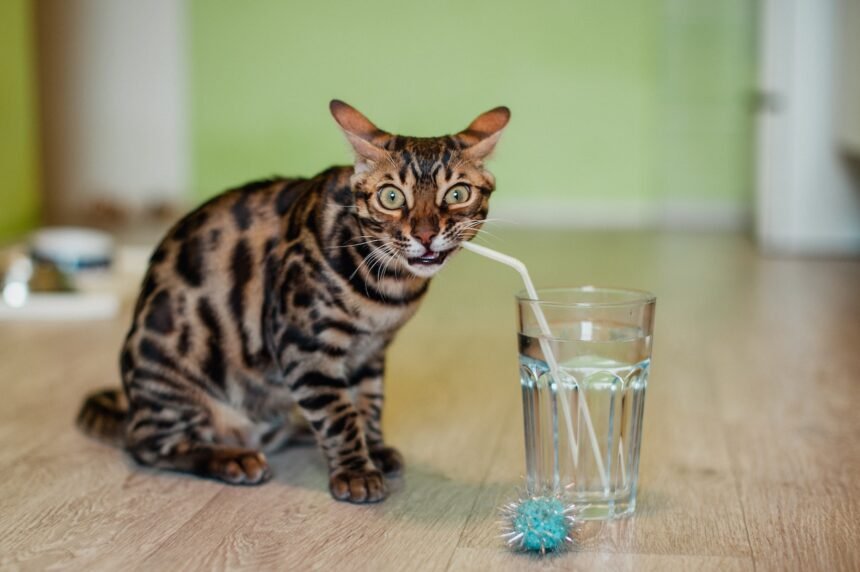Excessive water consumption in cats can be a perplexing and concerning behavior for many pet owners. Cats are known for their low water intake compared to other animals, making sudden increases in water consumption particularly noticeable. This article aims to shed light on the reasons behind why a cat may be drinking a lot of water and help owners better understand this puzzling behavior.
Understanding normal water intake for cats
Before determining if a cat’s water consumption is excessive, it’s essential to have a clear understanding of normal water intake for cats. On average, a healthy cat will consume approximately 5-10 ounces (150-300 milliliters) of water per day. Factors such as diet, age, activity level, and environmental conditions can influence water intake. By establishing a baseline of normal water consumption, it becomes easier to identify if a cat is indeed drinking more water than usual.
Possible medical causes for increased water intake in cats
Increased water intake in cats can be attributed to various underlying medical conditions. One common cause is diabetes mellitus, a condition characterized by elevated blood glucose levels. Another potential cause is chronic kidney disease, which affects the kidneys’ ability to concentrate urine properly. Hyperthyroidism, an overactive thyroid gland, can also lead to excessive thirst. Additionally, urinary tract infections and other urinary disorders can cause increased water intake in cats. It’s crucial to be aware of these potential medical causes as they often require veterinary intervention.
Behavioral factors contributing to increased water consumption
While medical conditions are often responsible for increased water intake, behavioral factors can also play a role. Environmental changes and stressors, such as moving to a new home or the presence of new pets, may cause a cat to drink more water. Additionally, some cats have preferences for certain types of water sources or may be more inclined to drink when their food contains higher levels of sodium. Understanding these behavioral factors can assist in addressing the issue effectively.
Identifying the signs of excessive water intake in cats
Identifying the signs of excessive water intake in cats is crucial for determining if there is a cause for concern. Monitoring water consumption patterns is essential. Keep track of how much water your cat is drinking on a daily basis and compare it to their normal intake. Frequent urination and changes in litter box habits, such as larger clumps or more frequent visits, can also indicate increased water intake. Additionally, be vigilant for other symptoms like weight loss, lethargy, increased appetite, or changes in coat quality. These signs, when observed alongside excessive water consumption, may provide valuable clues for further investigation.
When to consult a veterinarian: Seeking professional advice
If you notice persistent and significant increases in your cat’s water intake, it is important to consult a veterinarian. Keeping track of your cat’s water intake and documenting any changes or accompanying symptoms will help the veterinarian in making an accurate diagnosis. Discuss your concerns with the veterinarian, providing as much information as possible. They will be able to perform a thorough examination and recommend appropriate diagnostic tests to identify the underlying cause.
Diagnostic tests and evaluations for excessive water consumption in cats
To determine the cause of excessive water consumption, veterinarians may conduct various diagnostic tests. Blood tests are commonly performed to analyze kidney function, blood glucose levels, and other essential parameters. Urinalysis helps detect urinary abnormalities and infections. Depending on the clinical findings, additional diagnostic procedures, such as imaging techniques or specific tests for endocrine disorders, may be recommended. These tests are crucial in pinpointing the underlying cause and guiding the treatment plan.
Treatment options for underlying medical conditions
Treatment options for excessive water consumption depend on the underlying medical condition. For diabetes mellitus, management often involves dietary adjustments, medication, and possibly insulin therapy. Chronic kidney disease treatment focuses on supporting kidney function through specialized diets, medication, and other supportive care measures. Hyperthyroidism may be treated with medication, radioactive iodine therapy, or surgery. Urinary tract infections and related conditions are typically addressed with antibiotics or other appropriate therapies. Each medical condition requires specific treatment protocols that should be discussed with a veterinarian.
Lifestyle and environmental adjustments to promote hydration in cats
In addition to addressing underlying medical conditions, making lifestyle and environmental adjustments can help promote hydration in cats. Providing clean and fresh water sources is crucial. Ensure that water bowls are cleaned regularly and offer multiple water stations throughout the house. Some cats prefer running water, so a cat fountain may be beneficial in encouraging them to drink more. Wet food, which has a higher moisture content, can also contribute to their overall hydration. Environmental enrichment, such as interactive toys and playtime, can stimulate a cat’s natural drinking instincts. Reducing stressors in the environment, such as providing a quiet and safe space, can also help alleviate excessive water consumption.
Conclusion: Caring for a cat with increased water consumption
Understanding why a cat is drinking a lot of water is vital for providing appropriate care and management. Excessive water consumption can be indicative of underlying medical conditions or influenced by behavioral factors. Monitoring water intake, recognizing signs of excessive thirst, and consulting a veterinarian when necessary are essential steps in identifying and addressing the issue. Diagnostic tests and evaluations are performed to determine the root cause, and treatment options are tailored to the specific condition. Lifestyle adjustments, such as promoting hydration through clean water sources, wet food, and environmental enrichment, can complement medical interventions. By taking a comprehensive approach and working closely with a veterinarian, cat owners can ensure the well-being of their feline companions experiencing increased water consumption.







